Physical Address
304 North Cardinal St.
Dorchester Center, MA 02124
Common arterial trunk is an uncommon congenital cardiac lesion. The essential anatomic characteristic is the presence of a common ventriculoarterial junction that gives rise to an arterial trunk. This, in turn, gives rise to the systemic, pulmonary, and coronary circulations. In this chapter, we examine some of the details of this anatomic arrangement, the methods whereby the condition is diagnosed, and the techniques for its surgical treatment. There are increasing data on the long-term outcomes for patients born with this condition and of the importance of lifelong surveillance, which will also be examined.
Common arterial trunk is a rare anomaly. Within the state of Texas, the prevalence of nonsyndromic common arterial trunk was 0.035 per 1000 live births, with a significant increase in the risk occurring with advancing maternal age and maternal residence near the border between Texas and Mexico. Extracardiac abnormalities are common in these patients. Of 554 patients with common arterial trunk entered in the database of the Society of Thoracic Surgeons, 204 had some associated noncardiac abnormality, genetic abnormality, or a generalized syndrome. The incidence of congenital malformations of the heart is known to be increased in the offspring of patients with common arterial trunk, being 6.6% in the offspring of those with uncomplicated lesions and 13.6% of those with complex forms of the condition.
Of all the congenital lesions that benefit from being described in a straightforward fashion, common arterial trunk is the most obvious. When described in terms of “truncus,” which is a poorly defined embryologic term, it is always necessary to provide a subsequent definition of the lesion as seen in the postnatal heart. Describing the entity as a common arterial trunk negates the need for further definition ( Fig. 40.1 ). Almost always, the common ventriculoarterial junction is guarded by a common arterial valve. Rare cases have now been described in which the common valve is divided into separate orifices for the right and left ventricles, with the raphe between the valvar orifices bound down to the crest of the ventricular septum so that shunting takes place at arterial level. The pattern of branching of the common trunk itself can be complicated by various arrangements of the individual arteries within the systemic, pulmonary, and coronary arterial circulations. The presence of the common trunk, nonetheless, distinguishes the entity from patients having doubly committed ventricular septal defects, in which, although separate aortic and pulmonary valvar orifices are found within a common ventriculoarterial junction, the shunting is confined at ventricular level. It also distinguishes the lesions from the “close cousins” in which there is a window between the intrapericardial components of the aorta and pulmonary trunk, and also those patients in which a large patent trunk leaves the base of the heart in company with an atretic trunk, which can itself be traced from its origin at the ventricular mass. However, one variant that can still give problems in terms of description is when there is complete absence of the intrapericardial pulmonary arteries. Collett and Edwards included this variant as the so-called type IV within their overall grouping. However, the trunk arising from the ventricular mass in this setting is best described as a solitary, rather than a common, trunk. This is because there is no way of knowing, had they been present, whether the intrapericardial pulmonary arteries would have originated from the arterial trunk or from the right ventricular outflow tract ( Fig. 40.2 ). In terms of clinical presentation and treatment, such patients with a solitary arterial trunk have more affinities with tetralogy and pulmonary atresia (see Chapter 36 ) than with common arterial trunk.
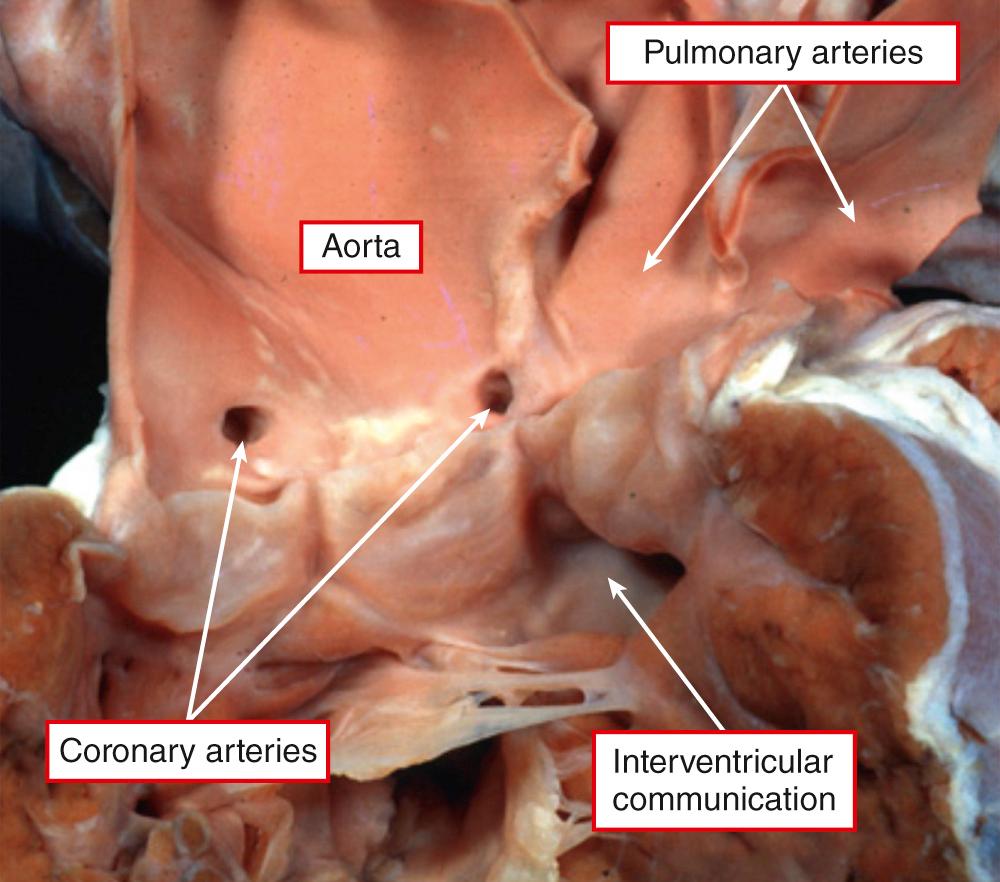
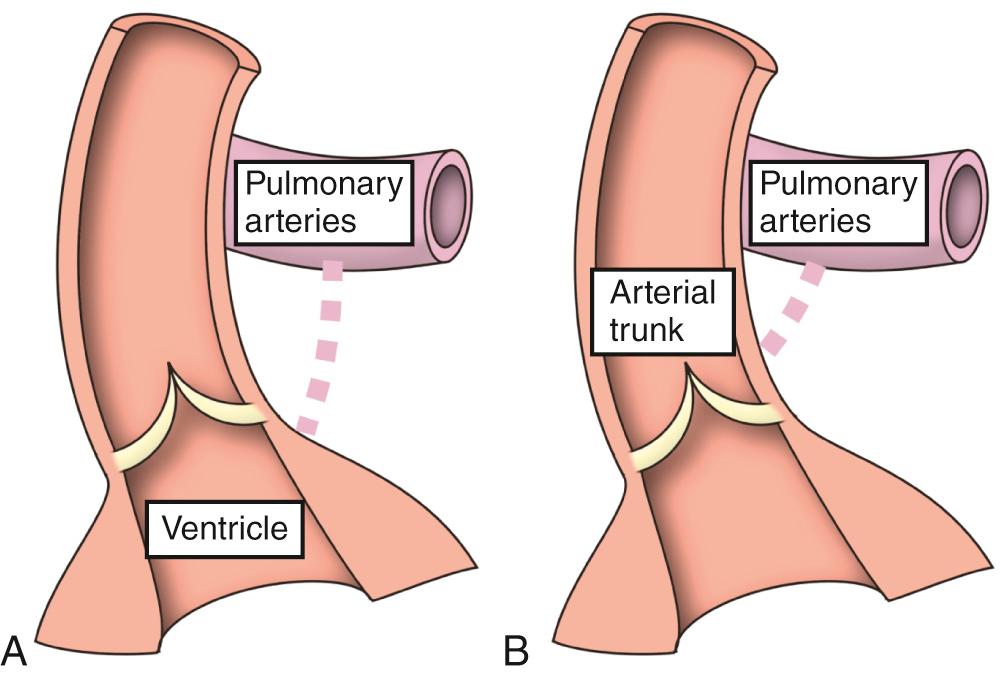
Therefore a common arterial trunk is one form of single outlet from the heart. As a malformation involving the ventriculoarterial junctions, it must be anticipated to coexist with all possible segmental combinations. In almost all instances, nonetheless, there will be a usual atrial arrangement, with concordant atrioventricular connections. Examples can be found in combination with discordant atrioventricular connections or with absence of the right atrioventricular connection. Although the atrioventricular junctions themselves are usually separate, and guarded by mitral and tricuspid valves, a common trunk can rarely be found in association with an atrioventricular septal defect and a common atrioventricular valve. In the presence of the common trunk, the truncal valve is almost always connected across the ventriculoarterial junctions with both ventricles, the valvar orifice overriding the ventricular septal crest, and typically with its leaflets in fibrous continuity with the mitral valve in the left ventricle ( Fig. 40.3 ). Such a biventricular connection necessitates the presence of a juxtaarterial interventricular communication. The defect is generally large. Its floor is the crest of the ventricular septum, reinforced on the right ventricular aspect by the limbs of the septomarginal trabeculation, or septal band, and its roof is the leaflets of the truncal valve. The cone of space subtended by the truncal valve has right and left ventricular margins, but it is usually the right ventricular margin that is considered to represent the ventricular septal defect, and it is this space that is closed by the surgeon during repair. In the majority of cases, fusion of the inferior limb of the septomarginal trabeculation with the ventriculoinfundibular fold along this right ventricular margin produces muscular discontinuity between the leaflets of the tricuspid and the truncal valves ( Fig. 40.4 , left ). In the absence of such fusion, there is continuity between the leaflets of the tricuspid and truncal valves, making the ventricular septal defect perimembranous (see Fig. 40.4 , right ). When present, this muscular bar in the posteroinferior margin protects the specialized axis responsible for atrioventricular conduction. In most instances, there is a large distance between the coapting arterial valvar leaflets and the crest of the septum during ventricular diastole when the leaflets are closed. However, this space may sometimes be reduced or the leaflets may close directly on the septal crest ( Fig. 40.5 , left ). Some have described this latter arrangement as representing an “intact ventricular septum.” This is somewhat misleading because, even in this arrangement, a septal deficiency is seen at the ventricular level when the truncal valve opens during ventricular systole (see Fig. 40.5 , left ). Furthermore, hearts are found when the ventricular septum is truly intact, the common trunk arising in most instances exclusively from the right ventricle (see Fig. 40.5 , right ). The interventricular communication can also be restrictive when the common trunk takes an exclusive origin from one or the other ventricle. Such a restrictive ventricular septal defect is more likely to produce problems when the trunk arises exclusively from the right ventricle (see Fig. 40.3 , right ).
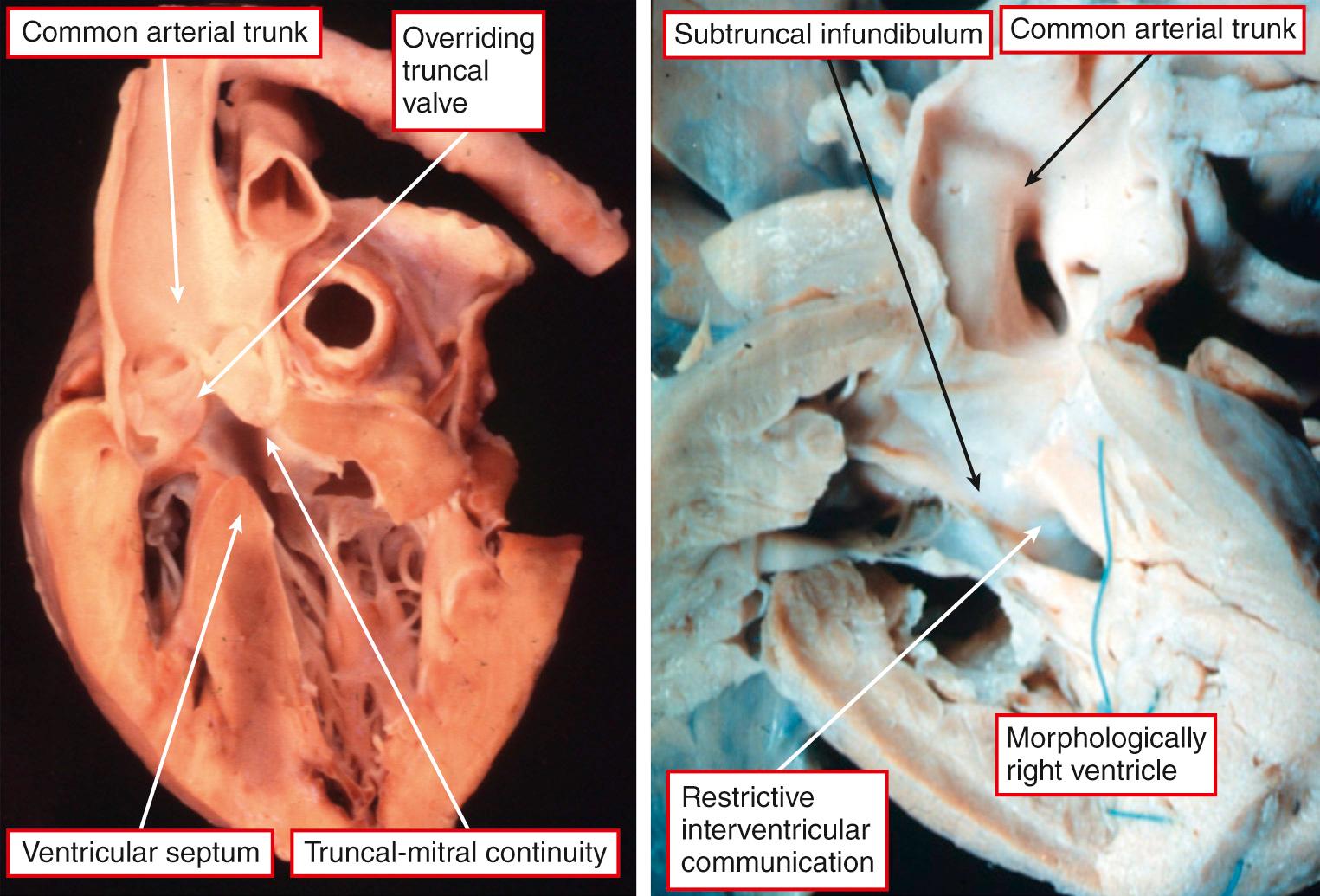
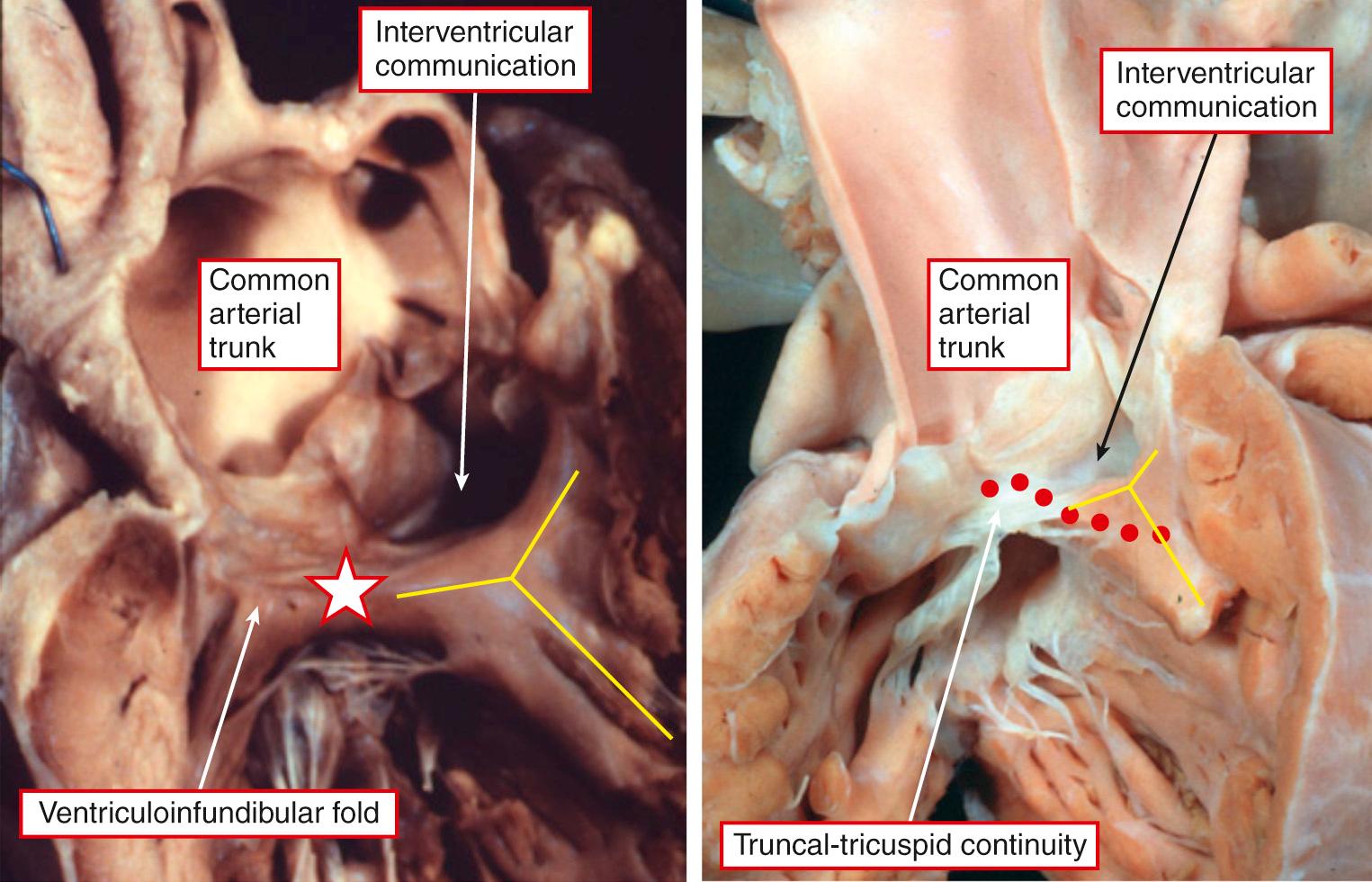
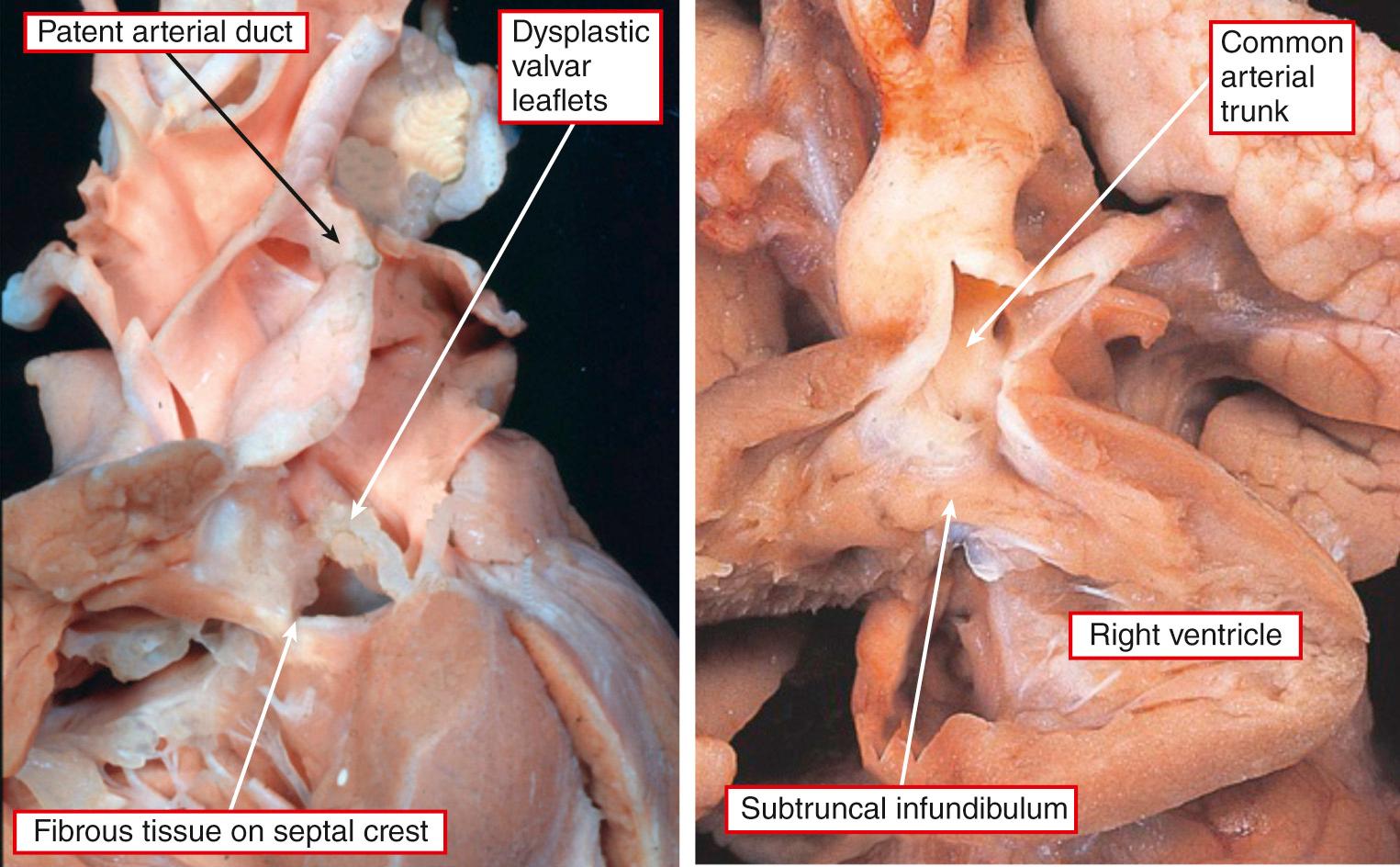
The truncal valve has three leaflets in approximately two-thirds of patients. In most of the remaining patients, either two or four leaflets are seen guarding the common arterial orifice. The leaflets are almost always in fibrous continuity with the anterosuperior leaflet of the mitral valve (see Fig. 40.3 , left ), but there can be a completely muscular subtruncal infundibulum, particularly when the common trunk arises exclusively from the right ventricle (see Figs. 40.3 , right, and 40.5, right ). Insufficiency of the truncal valve is not uncommon and can be caused by thickened and dysplastic leaflets or by prolapse of unsupported leaflets as a result of dilation of the ventriculoarterial junction. Truncal valvar stenosis is relatively uncommon. When present, it is usually because the valvar leaflets are dysplastic.
The greatest anatomic variability is found in the pattern of the branching of the common trunk. The presence of a right-sided aortic arch, with mirror-imaged branching of the brachiocephalic arteries, is associated more often with common trunk, occurring in up to one-third of patients, than with any other congenital cardiac malformation. Hypoplasia of the aortic arch, with or without coarctation, is a particularly important associated finding but is less frequent than complete interruption of the arch. Such interruption is one of the major subgroups recognized in the alpha-numeric system that was suggested by Van Praagh and Van Praagh for classification. However, it is better to follow the suggestion made initially by the Van Praaghs, namely to categorize the defects in terms of aortic or pulmonary dominance of the common trunk.
When the arch is interrupted, the persistently patent arterial duct feeds the descending thoracic aorta and part of the brachiocephalic circulation, the precise proportion depending on the site of interruption. As with other forms of interruption of the aortic arch (see Chapter 45 ), retroesophageal origin of the right subclavian artery is frequently seen. Apart from those hearts with severe coarctation or interruption, or in which the pulmonary arteries are discontinuous, and one is fed through a patent duct, it is rare to find ductal patency coexisting with common arterial trunk, although it does exist (see Fig. 40.5 , left ). The state of the aortic arch is possibly the most significant clinical associated malformation found with common arterial trunk. It was the arrangement of origin of the pulmonary arteries, following the system proposed by Collett and Edwards, which was, in the past, most frequently used for numeric classification. This system largely accounts for aortic dominance, with the pulmonary arteries typically arising from the left posterolateral aspect of the aortic dominant common trunk, taking origin a short distance above the truncal valve. On occasion, they can take their origin directly from a truncal arterial valvar sinus. However, the arrangement in which the right and left arteries can take separate origin from the posterior aspect of the trunk, producing the so-called type III variant is the pattern found with pulmonary dominance ( Fig. 40.6 , right ). Describing aortic dominance and providing a precise description for the origin of the pulmonary arteries negate the need to resort to describing “type one and one-half.” In this regard, it is possible to find examples in which only one pulmonary artery arises from the common trunk, the other being supplied initially through a duct that became ligamentous. In the clinical setting, this can present as “unilateral absence” of one pulmonary artery, but almost always the “absent” artery is identified within the hilum of the lung. When this arrangement is found with common trunk, the discontinuous pulmonary artery initially fed by the duct is most frequently on the same side as the aortic arch. This is in contrast to the finding in patients with tetralogy of Fallot when one pulmonary artery is absent because in this setting the discontinuous artery is more frequently on the side opposite the aortic arch. In some circumstances, the pulmonary artery feeding the right lung is to the left at its origin from the common trunk relative to the artery running to the left lung. The two arteries spiral as they extend to the pulmonary hilums. This entity is called “crossed pulmonary arteries.” It is also possible for one pulmonary artery to arise directly from the ascending aorta, whereas the other takes its origin from the right ventricle. Some call this malformation “hemitruncus.” This is incorrect because, of necessity, the hearts have separate ventriculoarterial junctions, guarded by separate aortic and pulmonary arterial valves. They cannot therefore be examples of common arterial trunk.
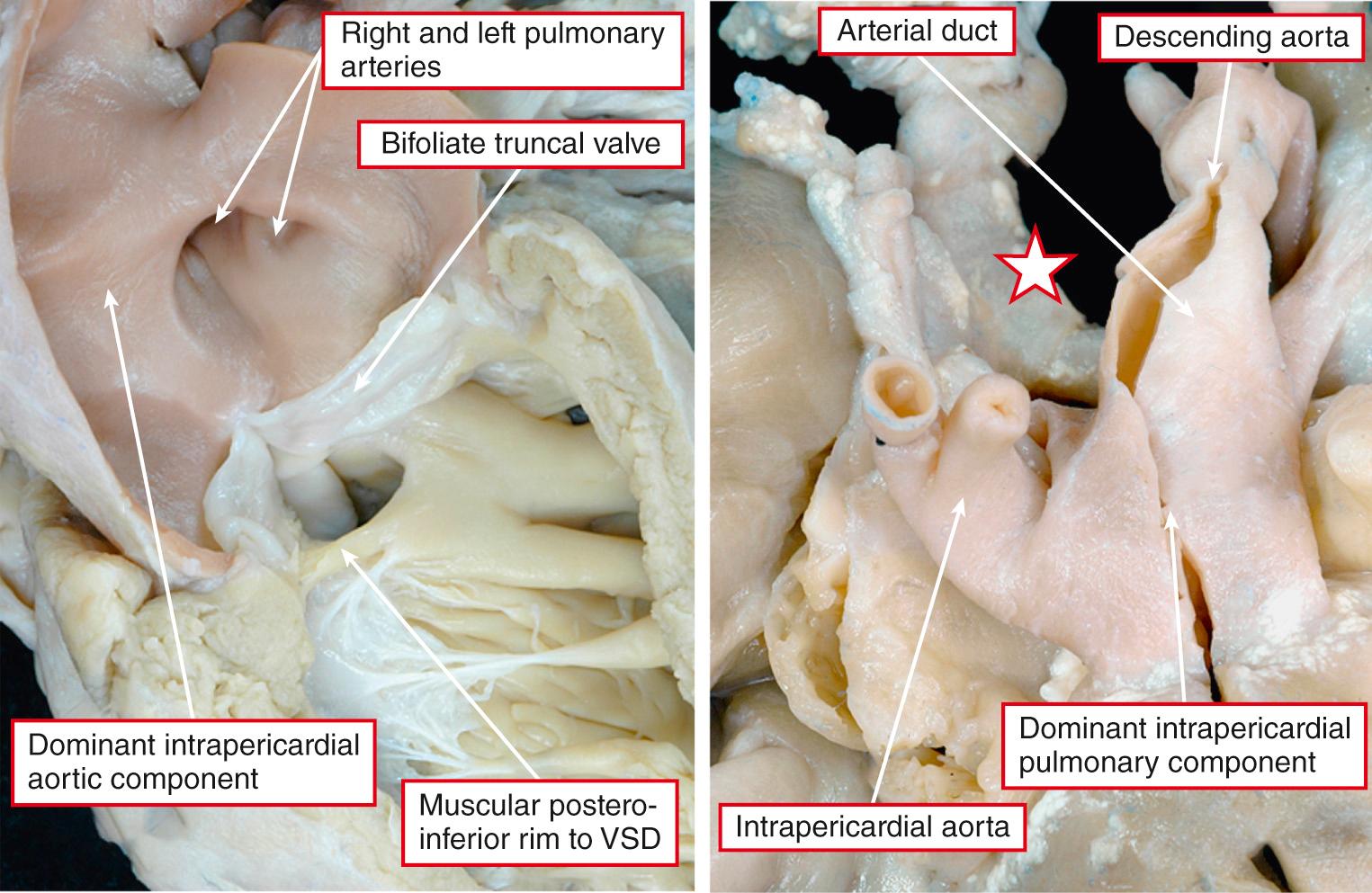
Anomalies of the origin and distribution of the coronary arteries are frequent. Unlike the situation when there are separate aortic and pulmonary valves, in which virtually without exception the coronary arteries arise from one or other of the aortic valvar sinuses adjacent to the pulmonary trunk, and usually both sinuses, there is no constant pattern of sinusal origin in the presence of a common ventricular outflow tract. Instead, the coronary arteries can arise from any of the truncal valvar sinuses, albeit that in most instances there are still two coronary arteries, with the left artery giving rise to anterior interventricular and circumflex branches. The arteries often arise close to a zone of apposition between the valvar leaflets, and origin above the sinutubular junction is quite common. This can produce potential difficulties during surgical correction should the high origin be adjacent to the origin of the pulmonary arteries.
Knowledge of location of the atrioventricular conduction axis is also important when planning surgical repair. The sinus node and the atrioventricular node are normal in their location and structure. Having taken origin from the atrioventricular node, the penetrating atrioventricular bundle pierces through the central fibrous body, and the left bundle branch originates along the left ventricular septal endocardium (see Chapter 3 ). The right bundle branch travels within the myocardium of the ventricular septal crest, attaining a subendocardial course at the level of the moderator band. In those hearts in which a muscular bar interposes between the attachments of the truncal and tricuspid valves in the posteroinferior margin of the septal defect, the membranous septum is intact behind the muscular tissue, and the atrioventricular conduction tissues are somewhat distant from the rim of the defect (see Fig. 40.3 , left ). In contrast, in patients in whom the ventricular septal defect is perimembranous, the conduction tissue passes directly along the left aspect of the fibrous posteroinferior rim of the defect (see Fig. 40.3 , right ). It is then at greater surgical risk. We have already mentioned most of the common associated cardiovascular anomalies found in the setting of common arterial trunk, including a right aortic arch, interrupted aortic arch, patency of the arterial duct, discontinuity of one pulmonary artery, coronary arterial anomalies, and incompetent truncal valve. A defect within the oval fossa has been noted in up to one-fifth of patients, persistence of the left superior caval vein draining to the coronary sinus in up to one-tenth, and an aberrant subclavian artery in between one-tenth and one-twentieth. Partially anomalous pulmonary venous connection has also been reported.
The evidence now available shows that many cases of common arterial trunk result from a genetic defect. The evidence comes from interpretation of morphology, experiments in animals, studies on the role of cells migrating from the neural crest in the development of the outlet components of the heart and the arterial trunks, and the discovery of deletions in chromosome 22q11 in patients with malformations involving the outflow tracts—so-called conotruncal defects. The morphology of common arterial trunk supports very strongly the notion that, during development, there has been failure of septation of the ventricular outlets and the outflow segment of the heart tube. It had been suggested that the entity was produced in consequence of failure of formation of the subpulmonary infundibulum, with the common arterial trunk in essence representing the aorta. No evidence has accrued over the past decades to support this latter notion, but much has appeared to contradict it. Thus studies of cardiac development, on both normal and abnormal hearts, have always shown that the initially common ventricular outflow tract is separated by the contained endocardial cushions to produce the separate arterial roots and their supporting ventricular outflow tracts. Failure of such separation during embryologic development was demonstrated conclusively as producing common arterial trunk in an elegant study using Keeshond dogs published as long ago as 1978. The subsequent studies of Kirby and colleagues showed that, when the migration of the cells from the neural crest is perturbed, the cushions do not develop properly, and one of the lesions produced is common arterial trunk. Common arterial trunk has now been produced is multiple mouse models, such as the mouse with perturbation of the Furin enzyme ( Figs. 40.7 and 40.8 ). These studies also show that the variations in patterning of the intrapericardial arterial components depends on the extent of the aortopulmonary septum, formed by the protrusion from the dorsal wall of the aortic sac (see Chapter 3 ). Some of the perturbed embryos had doubly committed ventricular septal defects, rather than common arterial trunk. This is of particular interest because, as we have already discussed, the morphology of the outflow tracts is almost identical in the setting of a common arterial trunk and in doubly committed defects, apart from the finding of separate aortic and pulmonary valvar orifices in the latter malformations.
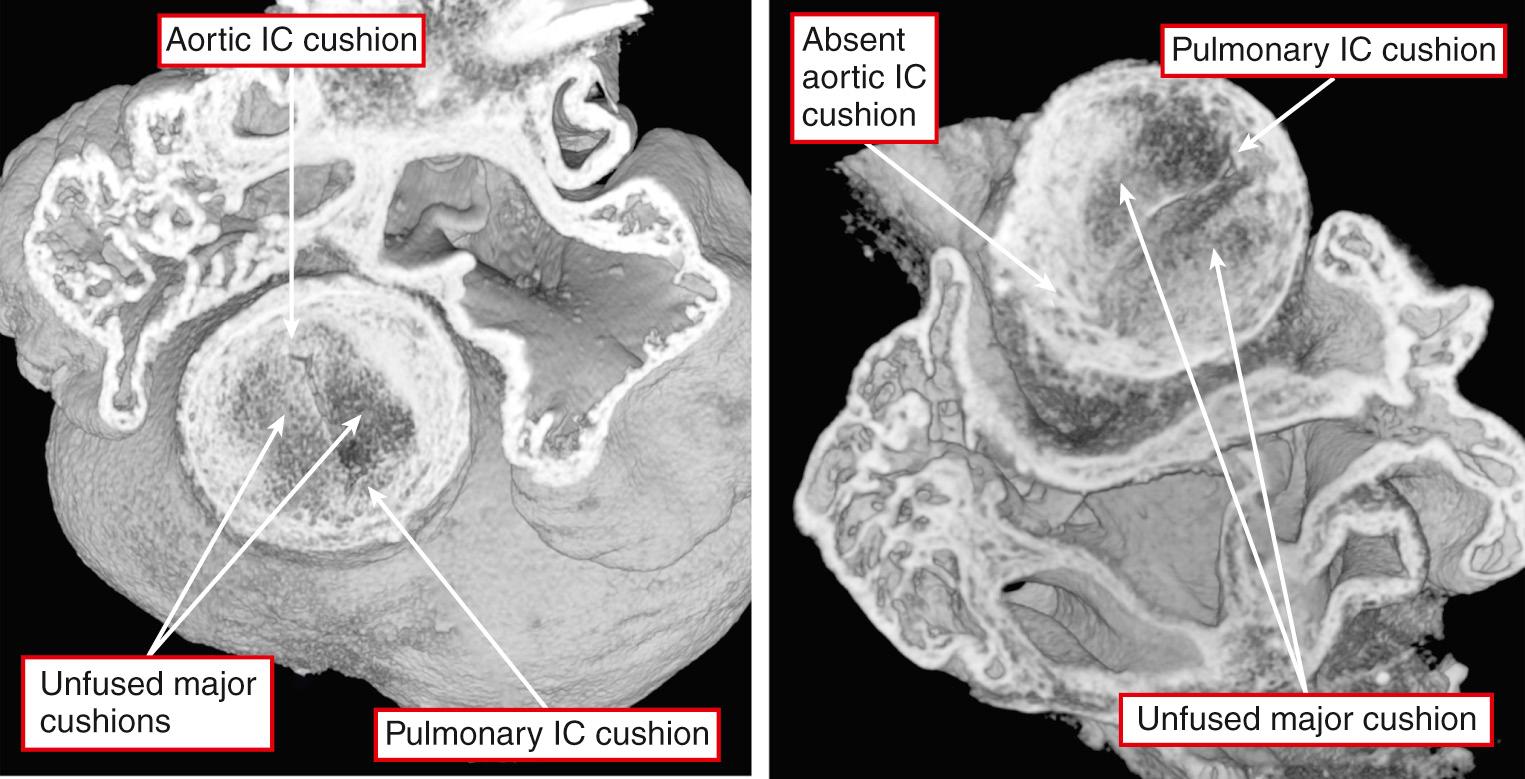
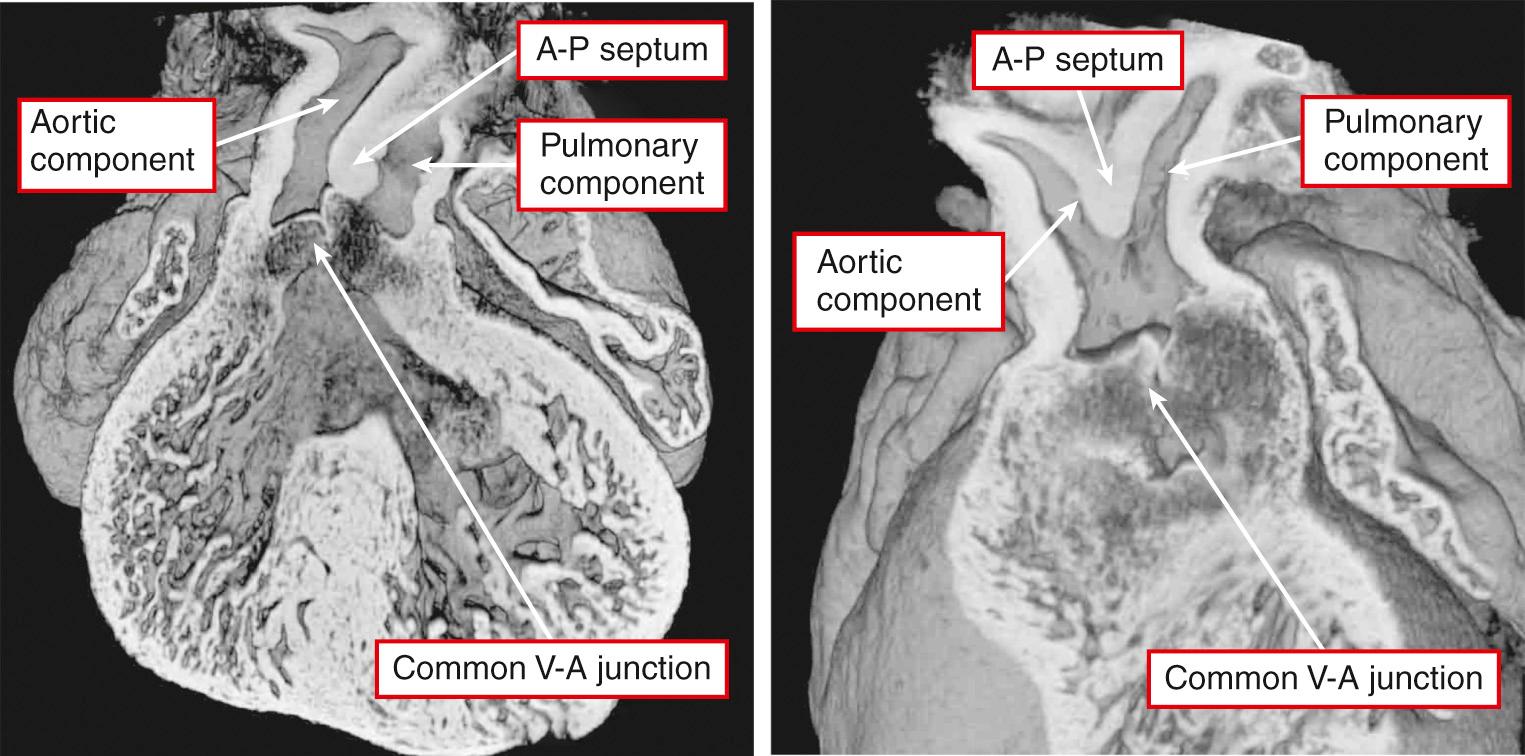
Become a Clinical Tree membership for Full access and enjoy Unlimited articles
If you are a member. Log in here